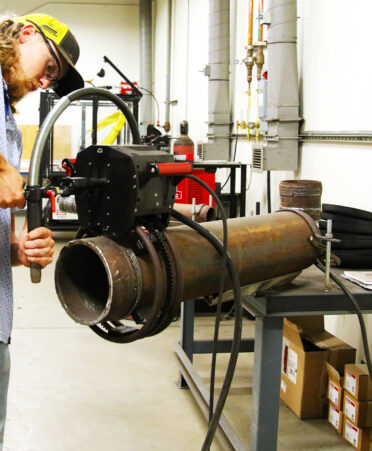(ROSENBERG, Texas) – Automation is the future for many industries, and welding is no exception.
Texas State Technical College’s Welding Technology automation lab at TSTC’s campus in Fort Bend County recently received new equipment to help keep TSTC students on the cusp of emerging technology and practices.
“We’ve got a submerged-arc machine, new orbital pipe welding machines, and another FANUC robotic arm,” TSTC Welding Technology instructor Alex Deibert said. “We’re able to better prepare these students for the new age of automation that’s coming in the welding industry.”
Deibert is particularly excited for the addition of the submerged-arc machine.
“What that’s going to allow us to teach our students now is sub-arc on pressure vessels,” he said. “We’ll be able to simulate that. There’s a lot of positions available for students who know how to run a sub-arc. There’s a large market for this.”
The orbital tube welder joins small-diameter tubing without the addition of filler metal. This type of equipment is typically seen in the food service industry at plants that need stainless steel sanitary tubing for their products.
The orbital TIG (tungsten inert gas) head, when properly fitted, can complete an entire weld on pipes measuring anywhere from 1 3/4 inches to 6 1/4 inches in diameter. An additional piece of equipment operates under the same principle, but uses different welding processes: MIG (metal inert gas) and flux-core.
The FANUC robotic arm operates on six axes and is tied to a welding power source. In the field, operators would write a program, add their welding parameters, and push Start. Then the robotic arm would get to work.
“You see this a lot in the manufacturing industry, especially in large-scale sheet-metal production like car stampings and stuff,” Deibert said. “Pretty much every car manufacturer has loads of these.”
Deibert has industry experience with automation in the welding world.
“One of the machines I was welding on, I was making an 18-inch flare stack,” he said. “From start to finish on an 18-inch diameter pipe, 42 minutes. It took a manual welder anywhere from two to three hours to make that weld.”
Automation will not replace all jobs in welding, Deibert said. But with more welders at or near retirement age and not enough new welders to replace them, technology will play a role in filling in the gaps.
“From a production standpoint, automation is great,” he said. “It is a very bright future in the industry. You can’t deny the fact that a robot can come in, do a good job, and do it quicker.”
Deibert wants prospective TSTC students to know that they will have the opportunity to train on industry-standard, high-quality equipment in the automation lab.
“The caliber of equipment we have here is top-notch,” he said. “We’re very fortunate, and we pride ourselves on having this type of equipment. This automation training is one of the things that differentiates TSTC from the other trade schools. They don’t have this.”
All 10 of TSTC’s campuses across the state offer training in Welding Technology, which is part of the college’s Money-Back Guarantee. If participating graduates do not find a job in their field within six months of earning their degree, TSTC will refund their tuition.
In Texas, welders can earn an average annual salary of $47,820, according to onetonline.org, which forecasts the number of these positions to grow in the state by 13% through 2028.
At 46,580, Texas employs the most welders in the nation, according to the U.S. Bureau of Labor Statistics. The Houston-The Woodlands-Sugar Land metropolitan area has the highest employment level of welders among all other metropolitan areas in the country.
Registration for TSTC’s fall semester is underway. Learn more at tstc.edu.
